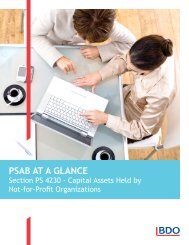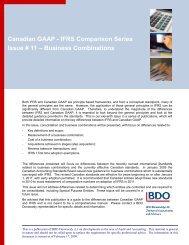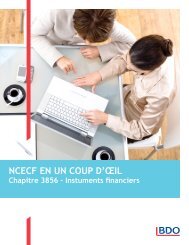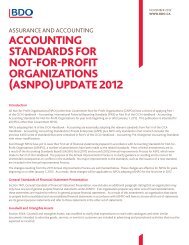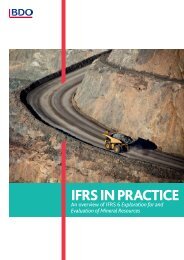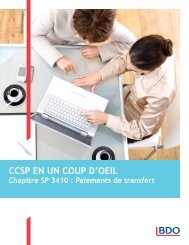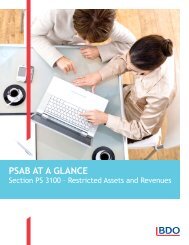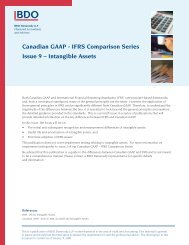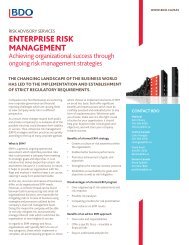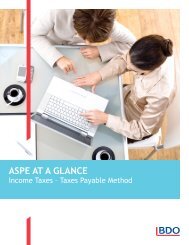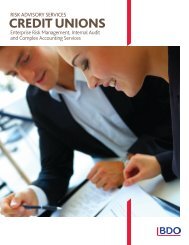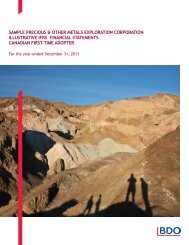12 <strong>IFRS</strong> <strong>10</strong> <strong>Consolidated</strong> <strong>Financial</strong> Statements7. Control7.1. The single control model7.1.1. Definition<strong>IFRS</strong> <strong>10</strong> <strong>Consolidated</strong> <strong>Financial</strong> Statements introduces a single control model for all entities. An inves<strong>to</strong>r controls aninvestee when:‘…the inves<strong>to</strong>r is exposed, or has rights, <strong>to</strong> variable returns from its involvement with the investee andhas the ability <strong>to</strong> affect those returns through its power over the investee.’Under the new guidance control is the sole basis for consolidation. The structure of the investee is not relevant.Consequently, the requirements of <strong>IFRS</strong> <strong>10</strong> apply <strong>to</strong> all inves<strong>to</strong>r/investee relationships, including what are nowtermed ‘structured entities’. These are broadly equivalent <strong>to</strong> Special Purpose Entities (SPEs) that previously fell withinthe scope of SIC-12 Consolidation—Special Purpose Entities.7.1.2. Assessment of control<strong>IFRS</strong> <strong>10</strong>.7 notes that an inves<strong>to</strong>r controls an investee if it has all of the following:––Power over the investee (whether or not that power is used in practice)––Exposure, or rights, <strong>to</strong> variable returns from its involvement with the investee––The ability <strong>to</strong> use its power <strong>to</strong> affect the amount of the inves<strong>to</strong>r’s returns.Control= + +Exposure <strong>to</strong>Powervariable returnsLinkage betweenpower andreturnsFigure 2: Assessment of controlAlthough this assessment appears similar <strong>to</strong> the approach previously required by IAS 27(2008) <strong>Consolidated</strong> andSeparate <strong>Financial</strong> Statements and SIC-12, there are key differences. In particular, because an inves<strong>to</strong>r must satisfy allthree of the criteria set out above, under <strong>IFRS</strong> <strong>10</strong> even if an inves<strong>to</strong>r has substantial exposure <strong>to</strong> variable returns ofanother entity, this is not sufficient by itself <strong>to</strong> conclude that control exists. This is in contrast <strong>to</strong>, for example, theanalysis carried out under SIC-12 where exposure <strong>to</strong> a majority of the benefits of an SPE gave rise <strong>to</strong> an assumptionthat control existed. However, in contrast with SIC-12, but consistent with IAS 27(2008), it is not necessary foran inves<strong>to</strong>r <strong>to</strong> be exposed <strong>to</strong> a majority of the benefits (or returns) of an investee in order for that investee <strong>to</strong> beaccounted for as a subsidiary.All facts and circumstances are required <strong>to</strong> be considered when an inves<strong>to</strong>r assesses whether it controls anotherentity. The following fac<strong>to</strong>rs may assist in the determination (<strong>IFRS</strong> <strong>10</strong>.B3):––The purpose and design of the investee––What the relevant activities are and how decisions about those activities are made––Whether the rights of the inves<strong>to</strong>r give it the current ability <strong>to</strong> direct the relevant activities––Whether the inves<strong>to</strong>r is exposed, or has rights, <strong>to</strong> variable returns from its involvement with the investee––Whether the inves<strong>to</strong>r has the ability <strong>to</strong> use its power over the investee <strong>to</strong> affect the amount of the inves<strong>to</strong>r’sreturns.
<strong>IFRS</strong> <strong>10</strong> <strong>Consolidated</strong> <strong>Financial</strong> Statements13In addition <strong>to</strong> focusing on an inves<strong>to</strong>r’s exposure <strong>to</strong> variable returns, and its ability <strong>to</strong> affect those returns byexercising its power over the investee, <strong>IFRS</strong> <strong>10</strong> introduces the new concept of ‘relevant activities’ (see section 7.2).These are defined as:‘…activities of the investee that significantly affect the investee’s returns.’This is a new concept that will require careful analysis. Although in some cases, they will be straightforward <strong>to</strong>identify and attribute, in others the approach will be more complex. In all cases, it will be necessary <strong>to</strong> analyse theactivities of an investee in order <strong>to</strong> determine which of its activities most significantly affect its profit or loss, and linkthis <strong>to</strong> an analysis of whether the inves<strong>to</strong>r has control over those activities.7.1.3. Purpose and designIn its assessment of whether it controls an investee, an inves<strong>to</strong>r is required <strong>to</strong> consider the purpose and design of theinvestee. This includes:––Identification of the relevant activities––How decisions about the relevant activities are made––Who has the current ability <strong>to</strong> direct those activities––Who receives returns from those activities.In many cases, inves<strong>to</strong>rs own equity instruments in investees that give the holder proportionate voting rights anda proportionate share in the returns generated by the investee. In those circumstances, provided no additionalcontractual agreements about decision making are in place, the control assessment will be based around whichinves<strong>to</strong>r is able <strong>to</strong> exercise sufficient voting rights <strong>to</strong> achieve control over the relevant activities. This will often beachieved through holding a majority of the voting rights.7.1.4. Continuous assessment<strong>IFRS</strong> <strong>10</strong> contains an explicit requirement for inves<strong>to</strong>r/investee relationships <strong>to</strong> be reassessed on a continuous basis.Although it was not a requirement of IAS 27(2008) or SIC-12, in practice the existence of control was reassessedwhen there was a change in facts and circumstances. For example, after the onset of the global financial crisis, anumber of SPEs that had not previously been consolidated were subsequently consolidated, due <strong>to</strong> obligationscrystallising that had previously been considered <strong>to</strong> have a remote risk of arising in practice.However, because certain parts of the analysis required by <strong>IFRS</strong> <strong>10</strong> are different and can be highly judgemental, inparticular when an investee is not wholly owned, the requirement for continuous reassessment may now be morecomplex.<strong>IFRS</strong> <strong>10</strong> gives examples of where an inves<strong>to</strong>r would need <strong>to</strong> revist its control assessment. These include:––Changes in Power – An inves<strong>to</strong>r can gain power over an investee because decision-making rights held by anotherparty or parties that previously prevented the inves<strong>to</strong>r from controlling an investee have lapsed (<strong>IFRS</strong> <strong>10</strong>.B82)––Changes affecting exposure <strong>to</strong> variable returns – For example, an inves<strong>to</strong>r that has power over an investee canlose control of an investee if the inves<strong>to</strong>r ceases <strong>to</strong> be entitled <strong>to</strong> receive returns or <strong>to</strong> be exposed <strong>to</strong> obligations(<strong>IFRS</strong> <strong>10</strong>.B83)––Changes in the linkage between power and returns – Changes in the relationship between the inves<strong>to</strong>r and otherparties can mean that an inves<strong>to</strong>r no longer acts as an agent, even though it has previously acted as an agent, andvice versa (see section 7.5.1 for a discussion of principal/agent relationships). For example, if changes <strong>to</strong> the rightsof the inves<strong>to</strong>r, or of other parties, occur, the inves<strong>to</strong>r is required <strong>to</strong> reconsider its status as a principal or an agent(<strong>IFRS</strong> <strong>10</strong>.B84). The initial assessment of control or its status as a principal or an agent would however not changebecause of a change in market conditions (e.g. a change in the investee’s returns driven by market conditions),unless the market changed one of the three criteria above or the overall relationship between the principal and theagent (<strong>IFRS</strong> <strong>10</strong>.B84/B85).



